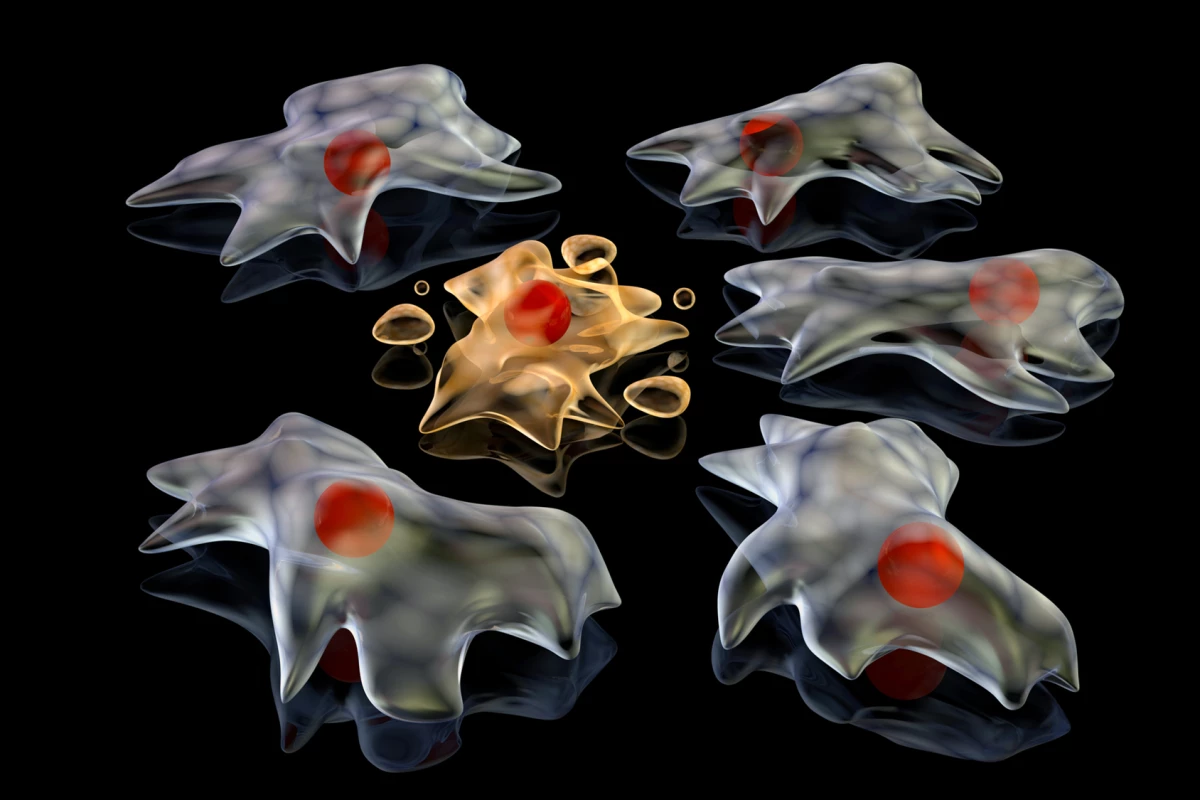Science
Scientists Uncover ‘Footprint of Death’ in Dying Cells

Research from **La Trobe University** has unveiled a significant discovery regarding cell death that may impact both immune responses and viral infections. Scientists have identified a physical trace, referred to as the “Footprint of Death” or FOOD, which could provide a pathway for viruses to spread, while simultaneously aiding the immune system in cleaning up dying cells.
When cells undergo apoptosis, a natural and programmed form of cell death, they emit various signals to attract nearby immune cells known as phagocytes. These signals, which include “find-me” and “eat-me” signals, are crucial for clearing cellular debris. The latest study highlights how dying cells leave behind a unique, membrane-encased footprint that remains attached to surfaces, directing phagocytes precisely to the site of cell death.
Professor Ivan Poon, co-corresponding author of the study and head of the laboratory at the **La Trobe Institute for Molecular Science**, emphasized the implications of this research. “Understanding this basic biological process could open new avenues of research to develop treatments that enhance the immune system’s ability to combat disease,” he stated. The study’s findings are particularly relevant given that billions of cells are programmed to die daily as part of normal cellular turnover and disease progression.
Through a combination of microscopy, live-cell imaging, protein analysis, and viral infection models, researchers investigated how FOOD is formed and functions. They induced apoptosis in human and mouse cells and utilized advanced microscopy techniques to observe the retracting cells leaving behind the FOOD structure. This footprint is rich in **F-actin**, a structural protein, and other adhesion proteins, distinguishing it from other extracellular vesicles that typically disperse.
The study revealed that adherent cells—cells attached to surfaces—retract their bodies upon death, leaving behind a thin footprint that remains anchored. Following this, the leftover membrane forms approximately 2-μm-wide vesicles known as FOOD-derived extracellular vesicles (F-ApoEVs). These vesicles emit an “eat-me” signal, prompting immune cells to engulf them. The process relies on the activation of **ROCK1**, a protein involved in cellular contraction; disruptions to ROCK1 hinder proper FOOT formation.
Analysis identified 601 proteins within the FOOD structures, predominantly related to cell structure and adhesion, with minimal nuclear or mitochondrial materials. This suggests that FOOD mainly contains membrane and cytoskeletal components.
When **macrophages**, a type of immune cell, were introduced near FOOD, they successfully recognized and engulfed the F-ApoEVs, thereby pinpointing the exact location of cell death. Interestingly, macrophages exposed to FOOD showed enhanced capacity to clear additional dying cells, indicating that this mechanism primes them for effective clearance.
The study also uncovered that in cells infected with **influenza A**, the FOOD and F-ApoEVs contained viral proteins and even complete virions, which are infectious viral particles. When mingled with healthy cells, these infected vesicles facilitated the spread of the virus. This dual role of FOOD—supporting immune cleanup while potentially serving as a viral reservoir—highlights a complex interplay between cell death and viral infection.
Lead author **Stephanie Rutter**, a PhD candidate and senior researcher in Poon’s lab, noted the unexpected implications of the findings. “We know the body clears away dead cell fragments to avoid inflammation and autoimmune diseases. What we didn’t expect was how viruses could leverage this process to propagate infection by hiding in F-ApoEVs,” she remarked.
The study also featured insights from **Georgia Atkin-Smith**, a senior postdoctoral researcher at the **Walter and Eliza Hall Institute of Medical Research**, who emphasized that dying cells might continue to communicate and influence immune function even after their demise.
Despite its groundbreaking findings, the study has limitations. Conducted primarily in vitro, the behavior of FOOD within living organisms remains uncertain. The formation of FOOD was mostly observed in adherent cells, raising questions about its role in free-floating cells, such as blood cells. Additionally, the long-term fate of FOOD structures within tissues, including whether they persist or degrade, is still unknown. The implications for viral spread were specific to influenza A, meaning other viruses might interact differently with this process.
Nevertheless, the discovery of FOOD offers potential avenues for future research. Given its role in guiding macrophage activity and clearing dead cells, it could inspire new strategies for tissue repair or inflammation control. Further investigation into FOOD may lead to therapies that fine-tune immune responses, enhancing our understanding of disease pathologies and paving the way for innovative treatments.
The study has been published in the journal **Nature Communications**, contributing to the growing body of knowledge surrounding cell death and its implications for health and disease.
-

 Lifestyle3 months ago
Lifestyle3 months agoLibraries Challenge Rising E-Book Costs Amid Growing Demand
-

 Sports3 months ago
Sports3 months agoTyreek Hill Responds to Tua Tagovailoa’s Comments on Team Dynamics
-

 Sports3 months ago
Sports3 months agoLiverpool Secures Agreement to Sign Young Striker Will Wright
-

 Lifestyle3 months ago
Lifestyle3 months agoSave Your Split Tomatoes: Expert Tips for Gardeners
-

 Lifestyle3 months ago
Lifestyle3 months agoPrincess Beatrice’s Daughter Athena Joins Siblings at London Parade
-

 World3 months ago
World3 months agoWinter Storms Lash New South Wales with Snow, Flood Risks
-

 Science3 months ago
Science3 months agoTrump Administration Moves to Repeal Key Climate Regulation
-

 Business3 months ago
Business3 months agoSoFi Technologies Shares Slip 2% Following Insider Stock Sale
-

 Science3 months ago
Science3 months agoNew Tool Reveals Link Between Horse Coat Condition and Parasites
-

 Science2 months ago
Science2 months agoSan Francisco Hosts Unique Contest to Identify “Performative Males”
-

 Sports3 months ago
Sports3 months agoElon Musk Sculpture Travels From Utah to Yosemite National Park
-

 Science3 months ago
Science3 months agoNew Study Confirms Humans Transported Stonehenge Bluestones









